


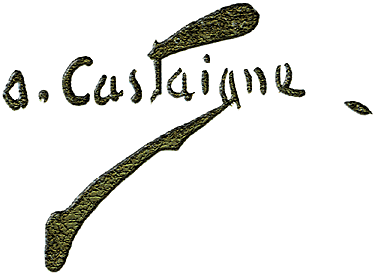 |
There are four Castaigne color pictures in issue #3 of and two pages in issue #5 of |
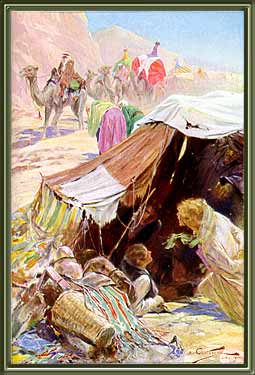 Is
the life of an illustrator his natural life? "Born such and
such, died then and when."
Is
the life of an illustrator his natural life? "Born such and
such, died then and when."
Is it his professional life? "Active from about 1890 to 1916."
Or is it the span of his work's influence and impact? How long he is remembered.
For André Castaigne, I can't tell you the answer to the first question and I've already answered the second. So allow me to go to work on the third.
By 1890, the growth of the illustrated magazine market was prodigious. The circulations of Scribner's, The Century and Harpers were expanding at astonishing rates and the competition among them, and from newcomers, was fierce. High on the list of attractions for readers were the pictures, but there weren't enough good artists to meet the demand.
Art schools sprang up in and around New York to train new illustrators, but their progeny wouldn't mature for several years. Editors and art directors turned their eyes East across the Atlantic. The ateliers, studios, salons and academies of Europe were teeming with young artists anxious to make good. Among them was a young Frenchman named André Castaigne.
As one of the European artists recruited by the magazine publishers to help meet the soaring demand for imagery each month, Andre Castaigne seemed to appear fully developed into the May 1891 issue of The Century with the illustration below for an article on Pioneer Mining in California. That's the earliest that I've encountered his work. It's amusing to consider that this image was probably painted in France for an article on California most likely written by a transplanted New Englander and published in New York. We can only guess at the accuracy of the scene.

Alhough I like and collect Castaigne, I know nothing about him other than he could paint anything with verisimilitude and he had an academic air about his work. The technique used on the cowboys dancing was worthy of the Paris salons, but that doesn't mean he studied there.
He's supposed to have. I spent several hours today scouring my library for any reference material on Castaigne and here's exactly all I could find about him (this from 200 Years of American Illustration by Henry Pitz):
"Born in France, he studied art under Angouléme, a painter. In 1888 he became a member of the Artists of France and from 1885 until 1896 he painted portraits of famous people, an example of which is his piece entitled Alexander le Grande a Memphis. In 1899 he was decorated with the Légion d' honneur. A popular book illustrator, he collaborated with W.T. Smedley and Orson Lowell to illustrate the Scribner edition, Love in Old Clothes."

|

|
|
Two of the 36+ drawings and paintings for Alexander the Great in The Century (November 1898 through October 1899) |
That's not much, and it turns out that it's not very accurate either. Angouléme is a city and I can't find reference to any artist or teacher with that name. The "Artists of France" seems also to be a phantom organization that has left no trace in my reference books. It's also very possible that the Alexander the Great painting was one of the dozens he did on the subject for an 1898-99 twelve part series in The Century. And the roles of the Légion de honneur show five Castaignes as recipients, but no Andre and the most recent was born in 1830. He did, however, produce three illustrations that were used in the 1896 Love in Old Clothes - though 'collaborated' might be too strong a word since each artist worked on a different story.
Thanks to Ron and François for some facts. Now let's check how well I did on my own.
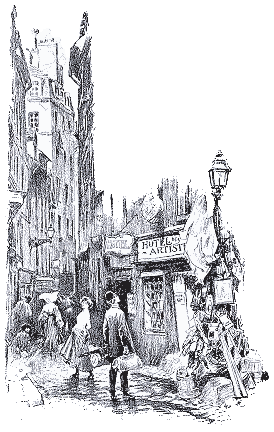
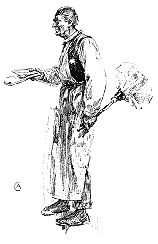 So,
what can I tell you about him? I believe he's French, not just
due to his name, but because he also dedicates one of the books
he wrote to "his many friends in America..." That book
is Fata Morgana, from 1904 and it is profusely illustrated
with plates and line drawings like those at left and right. Another
clue is that occasionally his paintings indicate, along with the
date and signature, that they were done in New York - a practice
many artists used to denote work done away from home.
So,
what can I tell you about him? I believe he's French, not just
due to his name, but because he also dedicates one of the books
he wrote to "his many friends in America..." That book
is Fata Morgana, from 1904 and it is profusely illustrated
with plates and line drawings like those at left and right. Another
clue is that occasionally his paintings indicate, along with the
date and signature, that they were done in New York - a practice
many artists used to denote work done away from home.
As to his age, I suggest that he was probably fairly young (under 25) when he did the 'Mining in California' piece above. I base that on the large, rather simplistic signature he used there, and in only a few other early pieces. My experience is that artists, very early on in their careers, settle on a signature and keep it. They might develop and/or embellish it over time, but seldom make radical changes. So let's put a lower limit of 1865 on the birthdate, making him about 26 in 1891 when he starts working in America and nearly forty when he wrote his first book. (see above for some real numbers.)
 He
was a prolific feature in The Century, with over 160 illustrations
before the end of 1895. That's nearly a painting a week for over
three years. If he had time to paint "portraits of famous
people", odds are that these turned up in American magazines.
He
was a prolific feature in The Century, with over 160 illustrations
before the end of 1895. That's nearly a painting a week for over
three years. If he had time to paint "portraits of famous
people", odds are that these turned up in American magazines.
He worked steadily for The Century until at least 1916 and in Harpers from 1901 to 1913. His work is also found at Scribner's as early as 1892 and as late as 1914. He appears in McClures between 1902 and 1910 and I've even seen one illustration in Everybody's from 1910. And the one other reference to him that I found (in The Dictionary of Book Illustrators and Caricaturists 1800-1914) reads in full: "Illustrator of royal events and social subjects for The Graphic, 1902,03 and 1905-10."
Plus he did dozens of books.
I'm especially fond of his color-plate books. They're not common - he perhaps did half a dozen. The image at the top of the page is from a 1911 orientalist adventure tale by Harold Macgrath titled The Carpet From Bagdad. But it was another 1911 potboiler that brought him his taste of everlasting fame.
 Published by Bobbs-Merrill and luridly titled
The Phantom of the Opera, this story by Gaston Leroux has
survived the decades and brought the one reminder of André Castaigne
along with it. There was even a fairly modern (1988) illustrated
reprint of the book from Mysterious Press.
Published by Bobbs-Merrill and luridly titled
The Phantom of the Opera, this story by Gaston Leroux has
survived the decades and brought the one reminder of André Castaigne
along with it. There was even a fairly modern (1988) illustrated
reprint of the book from Mysterious Press.
One of the very unique aspects of The Phantom is the nature of the plates. There are four of them, one of which is the standard frontispiece opposite the title page. Even this is a trifle different in that it is not bounded by a border, and the image bleeds off the paper at all four edges. The other three plates, however, are printed the width of the book and then folded and turned 90º. So if you were looking at the plate at left, you'd have opened the book and turned it a quarter turn to the right. I've seen this technique used on an occasional basis in a book, but never as the standard method for all the interior plates. Makes for gloriously large images, though. Click on the image for a larger sample.
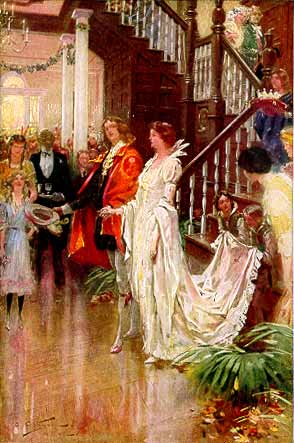 Other
books include the works of many of the most popular authors of
the day: The Adventures of Francois by S. Weir Mitchell,
The Maids of Paradise by Robert W. Chambers, The Marshal
by Mary Raymond Shipman Andrews, The Money Master by Gilbert
Parker, The Wonder-Book of Horses by James Baldwin, and
The Valiants of Virginia by Hallie Erminie Rives. This
last being simply another heart-throb society romance pot-boiler,
but Castaigne used it to show that he could be just as flashy
as Christy
or Fisher. See the image at right.
Other
books include the works of many of the most popular authors of
the day: The Adventures of Francois by S. Weir Mitchell,
The Maids of Paradise by Robert W. Chambers, The Marshal
by Mary Raymond Shipman Andrews, The Money Master by Gilbert
Parker, The Wonder-Book of Horses by James Baldwin, and
The Valiants of Virginia by Hallie Erminie Rives. This
last being simply another heart-throb society romance pot-boiler,
but Castaigne used it to show that he could be just as flashy
as Christy
or Fisher. See the image at right.
Just as I hope to impart some information to you with these essays, I want you to know that I learn things, too. While scanning the image at right I finally figured out why Christy, and Fisher, and Wenzell, and all of those stalwarts of the day drew such long and languid women. They had to fill up the darned page! With the standard aspect ratio of 3H x 2W, the taller you could make your figures, the less fol de rol you had to draw above and below. Expediency rather than style.
After 1916, or about at the age of 50 if our calculations are right, Castaigne disappears from print - at least from the contents of my library. I found one reference to him on the web with a death date of 1930. But, this listed him as being born in 1890, too, so I'm inclined to take that information with a grain of salt.
So, let's just say that André Castaigne spent about 25 years painting and drawing beautiful pictures for mass reproduction. All the information that's scattered across the net about him is merely mention of his name as an illustrator of a book - most often The Phantom of the Opera. Perhaps, like my page on Eric Pape, this essay will attract someone with more knowledge and the desire to share it.
And we'll extend Castaigne's life a little longer.

| any suggestions??? | |
| The Vadeboncoeur Collection of Knowledge | Jim Vadeboncoeur, Jr. 2000 |
| The Vadeboncoeur Collection of ImageS #3, B&W ImageS #5 | Jim Vadeboncoeur, Jr. 2002, 2010, JVJ Publishing |
| Illustrations are copyright by their respective owners. This page written, designed & © 2000 by Jim Vadeboncoeur, Jr. Updated 2011. |
